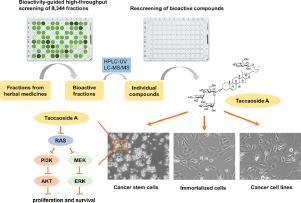Phytomedicine ( IF 6.7 ) Pub Date : 2022-10-06 , DOI: 10.1016/j.phymed.2022.154492 Dong Yang 1 , Zhi Dai 2 , Peifeng Zhu 3 , Gan Wang 4 , Bin Sun 1 , Shirong Li 1 , Junjun Hao 5 , Yifen Wang 3 , Yaping Liu 3 , Shuaishuai Yu 1 , Ren Lai 4 , Xiao-Dong Luo 6 , Xudong Zhao 7

|
Background
Cancer stem cells (CSCs) are characterized by their ability to self-renew, to differentiate into multiple cell types and also drive tumor formation, altogether making them important cellular targets for therapeutic intervention. However, existing CSC-targeting drugs do not significantly improve clinical outcomes. More recently, preclinical studies of natural product-derived compounds have demonstrated their potential usefulness as a therapeutic cancer treatment through their cytotoxic actions on CSCs.
Purpose
Here, we identify CSC-specific compounds derived from natural products and characterize their putative mechanisms of action in CSCs.
Methods
Glioblastoma stem cells (GSCs) were labeled with EGFP via homologous recombination and utilized for a high-throughput screen of 8,344 fractions from 386 herbal medicines. The fractions that extinguished EGFP fluorescence signal were then further characterized by LC-MS/MS. Next, several putative cytotoxic compounds were evaluated for their cytotoxic effects on GSCs, cancer cell lines and immortalized cells using a variety of methods to study cell proliferation (EdU incorporation assay), cell death (cleaved-Caspase-3 immunostaining), DNA damage (comet assay), mitochondrial membrane changes (JC-1 immunostaining), and tumor formation in vitro (soft agar colony forming assay). We also performed surface plasmon resonance analysis, western blotting, and immunohistochemistry to characterize the putative mechanisms underlying the cytotoxic effects of putative compounds on GSCs. Finally, we carried out xenograft tumor growth assays to study the cytotoxic potential of several candidates in vivo.
Results
Our high throughput screen led to the identification of the furostanol saponin taccaoside A and its two homologs from the rhizomatous geophyte Tacca. subflabellata that were cytotoxic to GSCs. Interestingly, the cytotoxic effect of taccaoside A on cell lines was significantly less compared to its homologs, owing to stereochemical differences of a carbon–carbon double bond between C-20 and C-22. Molecular studies revealed that taccaoside A binds to RAS to inhibit downstream effector signaling. Correspondingly, blockade of the interaction between taccaoside A and RAS abolished the inhibitory effect of this compound on CSCs. Furthermore, taccaoside A treatment was effective in limiting tumor cell growth in vivo.
Conclusion
Our study yielded an effective approach to screen for CSC-specific agents. Through this approach, we identified taccaoside A from the rhizomatous geophyte Tacca. subflabellata are cytotoxic to CSCs through a molecular mechanism that involves RAS binding and suppression of its downstream signaling. Our findings indicate taccaoside A is a potential lead compound for anti-CSC drug discovery.
中文翻译:

天然草药化合物的高通量筛选确定塔卡索苷 A 是一种细胞毒性化合物,可介导癌症干细胞中的 RAS 信号传导
背景
癌症干细胞 (CSC) 具有自我更新、分化成多种细胞类型以及驱动肿瘤形成的能力,这使它们成为治疗干预的重要细胞靶点。然而,现有的靶向 CSC 的药物并没有显着改善临床结果。最近,天然产物衍生化合物的临床前研究表明,它们通过对 CSC 的细胞毒性作用,可作为治疗癌症的潜在用途。
目的
在这里,我们确定了源自天然产物的 CSC 特异性化合物,并描述了它们在 CSC 中的推定作用机制。
方法
胶质母细胞瘤干细胞 (GSC) 通过同源重组用 EGFP 标记,并用于对来自 386 种草药的 8,344 个组分进行高通量筛选。然后通过 LC-MS/MS 进一步表征熄灭 EGFP 荧光信号的级分。接下来,使用多种方法研究细胞增殖(EdU 掺入测定)、细胞死亡(裂解的 Caspase-3 免疫染色)、DNA 损伤(彗星试验)、线粒体膜变化(JC-1 免疫染色)和体外肿瘤形成(软琼脂菌落形成试验)。我们还进行了表面等离子体共振分析、蛋白质印迹和免疫组织化学,以表征推定化合物对 GSC 的细胞毒性作用的推定机制。最后,我们进行了异种移植肿瘤生长试验,以研究几种候选物在体内的细胞毒性潜力。
结果
我们的高通量筛选导致从根茎地生植物 Tacca 中鉴定出呋甾醇皂苷 taccaoside A 及其两个同源物。对GSC具有细胞毒性的亚扇形藻。有趣的是,由于 C-20 和 C-22 之间碳-碳双键的立体化学差异,与其同系物相比,塔卡索苷 A 对细胞系的细胞毒性作用明显较小。分子研究表明,taccaoside A 与 RAS 结合可抑制下游效应信号。相应地,阻断 taccaoside A 和 RAS 之间的相互作用消除了该化合物对 CSC 的抑制作用。此外,塔卡索苷 A 治疗可有效限制体内肿瘤细胞生长。
结论
我们的研究产生了一种筛选 CSC 特异性药物的有效方法。通过这种方法,我们从根茎植物Tacca 中鉴定出 taccaoside A。subflabellata通过涉及 RAS 结合和抑制其下游信号传导的分子机制对 CSC 产生细胞毒性。我们的研究结果表明 taccaoside A 是抗 CSC 药物发现的潜在先导化合物。































 京公网安备 11010802027423号
京公网安备 11010802027423号